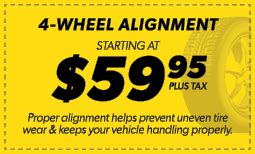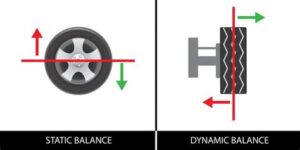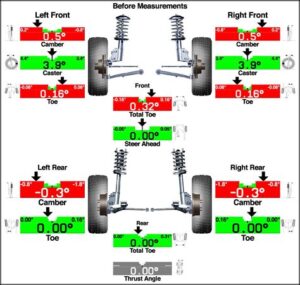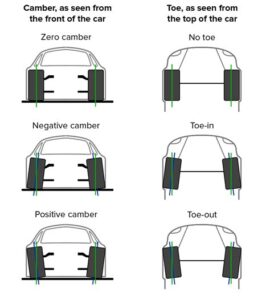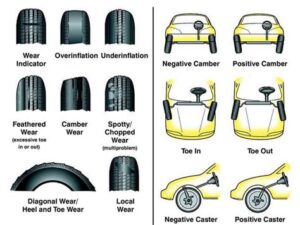Maintaining a well-aligned vehicle is essential for optimal performance and safety on the road, and one critical aspect of this is caster car alignment. Whether you’re an everyday driver or a car enthusiast, understanding the nuances of caster angles can significantly influence your steering stability and overall handling. The right caster alignment ensures that your vehicle responds smoothly to steering inputs, enhancing both comfort and control during your drive. In this article, we’ll delve into the importance of proper caster alignment, explore the common issues arising from misalignment, and outline the steps you can take to achieve optimal results. Plus, we’ll highlight the benefits of seeking professional caster car alignment services, ensuring your vehicle remains in peak condition. Join us as we navigate the world of caster alignment and help you drive with confidence.
Understanding Caster Car Alignment and Its Importance
Caster car alignment plays a crucial role in your vehicle’s overall performance and safety. It refers to the angle formed by the steering axis in relation to the vertical axis of the vehicle when viewed from the side. An optimal caster angle helps in maintaining straight-line stability and provides better handling during turns.
The tilt of the steering axis can be either positive or negative. Positive caster – where the top of the steering axis is tilted towards the rear of the vehicle – contributes to improved stability and better steering feedback. Conversely, negative caster can lead to instability and erratic handling. Thus, understanding the nuances of caster car alignment becomes essential for effective vehicle control.
Furthermore, proper caster car alignment minimizes tire wear and enhances tire life. Misalignment can cause uneven tire wear, leading to the need for premature replacement, which can be an expensive undertaking. Regularly checking and adjusting the caster angle not only helps in preserving tires but also improves fuel efficiency.
The importance of maintaining a correct caster car alignment cannot be overstated. It significantly impacts steering stability, handling, tire longevity, and overall driving safety. Regular checks should be a part of your vehicle maintenance routine to ensure optimal performance on the road.
How Caster Angle Affects Steering Stability and Handling
Understanding how the caster car angle impacts steering stability and handling is crucial for optimal vehicle performance. The caster angle refers to the angle formed by the steering axis when viewed from the side of the vehicle. This angle can either be positive or negative, and its adjustment plays a significant role in how a vehicle steers and responds to road conditions.
A positive caster angle, where the top of the steering axis is tilted towards the rear of the vehicle, typically enhances straight-line stability. This design allows the wheels to self-center when driving, making it easier for the driver to maintain control. As a result, vehicles with a proper positive caster angle tend to exhibit better handling during high-speed driving and on straight roads.
On the other hand, a negative caster angle, with the top of the steering axis tilted toward the front, can lead to a less stable ride. This can make steering feel vague or unresponsive, especially when navigating turns. Poor handling may result, causing increased wear on tires and suspension components.
Furthermore, the caster angle significantly influences the amount of feedback a driver receives through the steering wheel. With an appropriate caster car configuration, drivers experience better steering feedback, enhancing their ability to make quick and precise adjustments while driving.
Ensuring that the caster angle is correctly set not only aids in maintaining steering stability but also improves the overall handling characteristics of the vehicle. Regular checks and adjustments can prevent long-term issues that arise from improper caster car alignment.
Common Issues Caused by Poor Caster Car Alignment
Improper caster car alignment can lead to a variety of issues that affect your vehicle’s performance, safety, and maintenance costs. Here are some common problems you may encounter:
- Uneven Tire Wear: When the caster angle is off, tires may wear unevenly, leading to the need for premature replacements.
- Poor Steering Response: An incorrect caster angle can affect steering feel, making it less responsive and more difficult to control.
- Instability at High Speeds: Vehicles may feel unstable or wander on straight roads, compromising driver confidence.
- Increased Road Noise: Misalignment can cause tires to grip the road unevenly, resulting in increased vibrations and noise.
- Loss of Driving Comfort: Poor caster car alignment can lead to a rougher ride, making your driving experience less enjoyable.
- Impact on Braking: A misaligned vehicle may not stop as effectively, increasing stopping distances and compromising safety.
Regularly inspecting and maintaining proper caster car alignment can help prevent these issues and enhance overall driving performance.
Steps to Achieve Optimal Caster Car Alignment
Achieving optimal caster car alignment requires attention to detail and a systematic approach. Here are the key steps to ensure that your vehicle’s caster angle is set correctly for improved performance and safety:
| Step | Action |
|---|---|
| 1 | Check the Current Caster Angle: Use a caster camber gauge to measure the existing angles. Document these measurements for reference. |
| 2 | Evaluate Suspension Components: Inspect all front suspension components for wear or damage. Ensure that parts like control arms, bushings, and ball joints are in good condition. |
| 3 | Adjust Caster Angle: Depending on the measurement, adjust the caster angle by modifying adjustable components, like tie rods, or using shims for fixed components. |
| 4 | Ensure Other Alignments are Correct: While adjusting the caster, also check and adjust the camber and toe angles to maintain proper geometry. |
| 5 | Test Drive the Vehicle: After making adjustments, take the car for a test drive to assess steering response and handling efficiency. |
| 6 | Re-check Alignment: After the test drive, re-measure the caster, camber, and toe angles to confirm that they are within the recommended specifications. |
Following these steps for caster car alignment will lead to enhanced vehicle performance, ultimately contributing to driver safety and comfort. Regular alignment checks are also recommended to maintain optimal angles throughout the lifespan of your tires and suspensions.
Benefits of Professional Caster Car Alignment Services
Investing in professional caster car alignment services can significantly enhance your vehicle’s performance and longevity. Here are several key benefits:
- Precision: Professionals use advanced technology and equipment that ensures your vehicle’s caster angles are aligned according to manufacturer specifications, resulting in improved handling and safety.
- Time Efficiency: A trained technician can diagnose and correct issues more quickly than a DIY approach, allowing you to get back on the road sooner.
- Preventive Maintenance: Regular alignment checks can catch problems early, preventing costly repairs down the line and extending the life of your tires and suspension system.
- Enhanced Fuel Efficiency: Proper alignment reduces tire drag, allowing your caster car to consume less fuel. This not only saves you money but also reduces your carbon footprint.
- Safety Improvements: With the alignment correctly adjusted, your vehicle will respond better to steering inputs, reducing the chance of accidents caused by poor handling.
Choosing professional services for caster car alignment not only aids in achieving optimal vehicle performance but also offers peace of mind knowing that the job has been done right.
Frequently Asked Questions
What is caster alignment?
Caster alignment refers to the angle of the steering axis, which affects vehicle stability, steering effort, and cornering behavior.
Why is caster alignment important?
Proper caster alignment is crucial for maintaining vehicle control, ensuring even tire wear, and enhancing overall driving performance.
How do I know if my car needs caster alignment?
Symptoms of misalignment can include uneven tire wear, pulling to one side while driving, or a steering wheel that is off-center.
Can caster angle be adjusted?
Yes, the caster angle can often be adjusted through the vehicle’s suspension setup, although the specific adjustments depend on the make and model.
What is the ideal caster angle for most vehicles?
While the ideal caster angle can vary, most vehicles benefit from a positive caster angle between 2 to 5 degrees for optimal stability.
How often should I check my caster alignment?
It is advisable to check your caster alignment every time you rotate your tires, after hitting a significant pothole, or if you notice handling issues.
Does caster alignment affect fuel efficiency?
Yes, improper caster alignment can lead to increased rolling resistance, which may affect fuel efficiency as the vehicle works harder to maintain straight travel.
